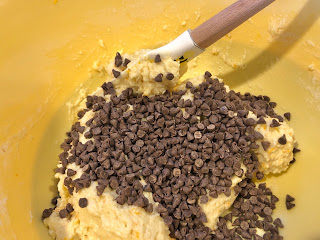
Recipe: Quick buttermilk bread includes plenty of zest

delightfully of fresh orange. (Photos: Kathy Morrison) |
Pairing orange and chocolate is my kind of delicious. I've always loved See's orange creams, chocolate-dipped orange peel and Swenson's Swiss orange chip ice cream. I know not everyone appreciates the marriage of chocolate and fruit; it's a personal preference.
But I also feel that if orange is supposed to be a prominent flavor in something, it really needs to stand out. Orange is so sweet that it can easily be overwhelmed by spices or other ingredients. So in adding chocolate to this quick bread, I made sure the orange flavor wasn't wimpy: The bread has zest from two entire navel oranges.
The recipe is based on a terrific basic buttermilk quick bread from thekitchn.com ; the writer Emma Christensen offers 10 other variations , and ideas to made your own favorite combination. So if you'd prefer coconut, or chopped nuts, or crystalized ginger with your orange, or no orange at all, jump in there. I'll stick with my very orange-y chocolate chip loaf and be quite happy.
Orange chocolate chip quick bread
Adapted from thekitchn.com
Makes 10 slices
Ingredients :
2 cups unbleached all-purpose flour
1/2 cup granulated

sugar
1-1/2 teaspoons baking powder
1/2 teaspoon baking soda
3/4 teaspoon salt
Zest from 2 medium or large navel oranges
1 cup buttermilk
1 large egg
1/4 cup unsalted butter, melted and cooled slightly
1/2 teaspoon vanilla extract
1/2 cup mini chocolate chips
Powdered sugar for topping, optional
Instructions :
Heat oven to 350 degrees. Grease a standard 9-by-5-inch loaf pan with cooking spray.
In a large bowl, stir or whisk together the flour, sugar, baking powder, baking soda, salt and orange zest.

In a medium bowl or glass measuring cup, stir together the buttermilk and the egg until blended, then stir in the melted butter and the vanilla extract.
Pour the liquid ingredients over the flour mixture and stir just until moistened. Carefully fold in the mini chips -- you don't want to overmix this batter.
Pour the batter into the prepared pan and even it out into the corners. Bake for 45 to 50 minutes, or until top is golden and a toothpick inserted in the center comes out clean. Let the bread cool in the pan for about 10 minutes before removing it. If desired, dust the top with powdered sugar before slicing.
Comments
0 comments have been posted.Sacramento Digs Gardening to your inbox.
Food in My Back Yard Series
May 6: Maintain soil moisture with mulch for garden success
April 29: What's (already) wrong with my tomato plants?
April 22: Should you stock up on fertilizer? (Yes!)
April 15: Grow culinary herbs in containers
April 8: When to plant summer vegetables
April 1: Don't be fooled by these garden myths
March 25: Fertilizer tips: How to 'feed' your vegetables for healthy growth
March 18: Time to give vegetable seedlings some more space
March 11: Ways to win the fight against weeds
March 4: Potatoes from the garden
Feb. 25: Plant a fruit tree now -- for later
Feb. 18: How to squeeze more food into less space
Feb. 11: When to plant? Consider staggering your transplants
Feb. 4: Starting in seed starting
Sites We Like
Garden Checklist for week of May 11
Make the most of the lower temperatures early in the week. We’ll be back in the 80s by Thursday.
* Plant, plant, plant! It’s prime planting season in the Sacramento area. Time to set out those tomato transplants along with peppers and eggplants. Pinch off any flowers on new transplants to make them concentrate on establishing roots instead of setting premature fruit.
* Direct-seed melons, cucumbers, summer squash, corn, radishes, pumpkins and annual herbs such as basil.
* Harvest cabbage, lettuce, peas and green onions.
* In the flower garden, direct-seed sunflowers, cosmos, salvia, zinnias, marigolds, celosia and asters. (You also can transplant seedlings for many of the same flowers.)
* Plant dahlia tubers.
* Transplant petunias, marigolds and perennial flowers such as astilbe, columbine, coneflowers, coreopsis, dahlias, rudbeckia and verbena.
* Keep an eye out for slugs, snails, earwigs and aphids that want to dine on tender new growth.
* Feed summer bloomers with a balanced fertilizer.
* For continued bloom, cut off spent flowers on roses as well as other flowering plants.
* Add mulch to the garden to maintain moisture. Mulch also cuts down on weeds. But don’t let it mound around the stems or trunks of trees or shrubs. Leave about a 6-inch-to-1-foot circle to avoid crown rot or other problems.
* Remember to weed! Pull those nasties before they set seed.
* Water early in the day and keep seedlings evenly moist.